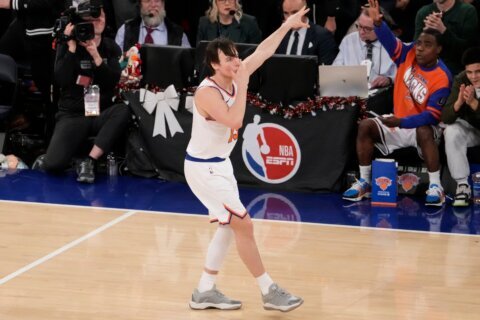WASHINGTON — At best, they’re invisible. At worst, they draw the ire of fan bases, have unimaginable insults and even death threats levied at them. And yet, sports officials put themselves in harm’s way, often for fairly low, non-guaranteed wages, without the protections many athletes enjoy.
Sure, there are some small spills, which are more embarrassing than painful.
But many others are more serious. Recently, a rash of officials in various sports have suffered significant injuries during games. An NHL official was upended and hit the ice on his back, breaking a rib. A couple months back, a college basketball official was elbowed in the temple on the opening tip and appeared to be knocked out with his eyes still open. Both ended up in the hospital.
And last Saturday, in the final seconds of overtime between Baylor and TCU, referee Ray Natili suffered an apparent hamstring injury running down the court. Natili is no novice — he’s reffed more than 1,200 games at the Division I level. He’s one of the lucky ones, able to make enough per game and cover enough games to make officiating his livelihood. Of course, when injury strikes, being a full-time official can be a drawback.
“These are guys, when you officiate basketball, a lot of them officiate four, five, six games a week,” said ESPN broadcaster Mark Neely after Natili’s injury. “You know, a hamstring issue is not a good thing for an official this time of year.”
It’s especially bad as a referee in the amateur ranks, where there are no professional unions to help safeguard against such on-the-job injuries. Refs pay for their own health insurance and are treated as independent contractors, their schedules often subject to the whim of the conferences or leagues that employ them.
According to Scott Armstrong of Portland, Ore., a longtime youth, high school and college referee and umpire, that means playing through pain sometimes.
“If you’re hurt, they might choose to not put you back on your old schedule when you get healthy again,” he says. “And if you’re not on the court, you’re worried someone might take your place.”
Armstrong, who has worked in baseball, basketball and soccer, sees first-hand examples all the time.
“I reffed with somebody the other day who’s got gout in his right leg right now, but took the assignment anyway, because he needs the assignments,” he says.
Armstrong says he’s fought through plantar fasciitis and turned ankles from poor surface conditions in soccer. But his worst injuries have all come from behind the plate in baseball.
He’s caught a ball under his mask that split his chin open. He’s been behind a catcher in a high school game who whiffed on an inside fastball, which caught him in the exposed part of his calf, keeping him from walking straight for two months. Last year, he was hit flush in the mask with a foul ball, and while he didn’t break anything, his jaw hurt for about six months.
Of course, officials are taught to try to prevent not just interference with game play, but also injury. In soccer, that means using the space the players aren’t in to get a good view while ensuring you aren’t in the way of a pass or a shot. In basketball, refs are taught to move two to three steps deep off the baseline to see all 10 players — sometimes that means contending with photographers or cheerleaders.
Hockey is the only sport, according to Armstrong, where officials aren’t discouraged from breaking up fights. But just because it’s allowed doesn’t mean it’s a good idea.
In a recent Caps-Leafs game, linesman Steve Miller came in to clean up the end of a fight and took a punch to the side of the head from Toronto defenseman Korbinian Holzer.
In the NHL, as well as every top-level professional league and Minor League Baseball, officials have union protection and health insurance. But even NFL officials such as Gene Steratore — who made the infamous call on the Dez Bryant non-catch last weekend — owns his own business and schedules time to work professional games.
The top guys in major college basketball, like Natili, can make anywhere from $800 to $2,000 a game, but rates vary widely. For most amateur refs, the game check is usually around $100 to $125 a night.
It’s worth remembering the next time you prepare to unleash a stream of vitriol at a guy in black and white stripes for a bad call. Many are there for the same reason as every sports fan — because they love the game. Enough so that they put their bodies on the line to be a part of it, which is more than most fans can say.
Follow @WTOP and @WTOPSports on Twitter and WTOP on Facebook.






